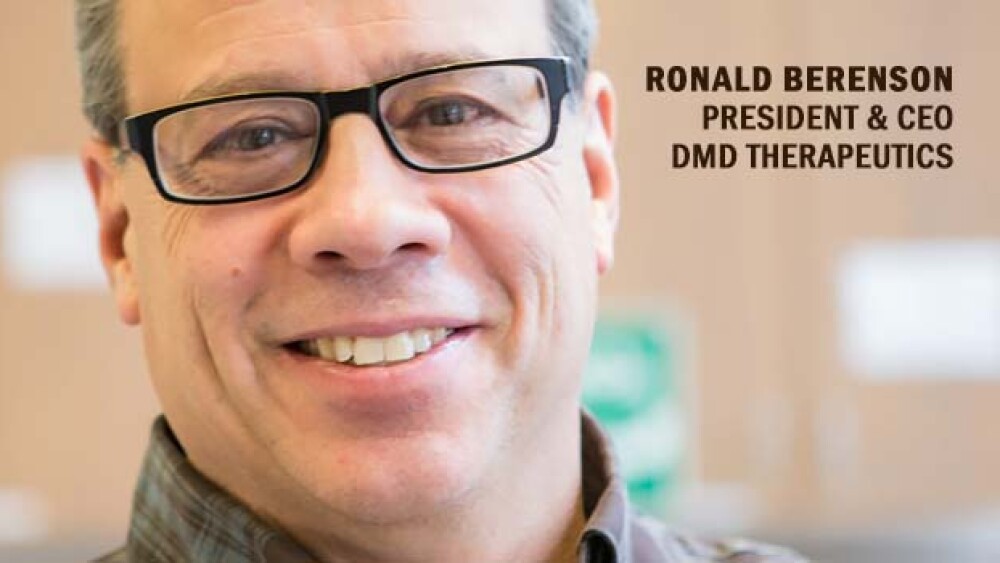DMD Therapeutics is based in Seattle, although at present it is a virtual company, and, as its name suggests, is focused on developing therapeutics for DMD.
DMD Therapeutics is based in Seattle, although at present it is a virtual company, and, as its name suggests, is focused on developing therapeutics for Duchenne muscular dystrophy (DMD).
DMD is a rare muscle-wasting disease caused by mutations in the dystrophin gene. It is a progressive disease and generally results in death in early adulthood. Serious complications include heart or respiratory-related problems. It affects mostly boys, about 1 in every 3,500 to 5,000 male children.
Ron Berenson, the company’s cofounder and chief executive officer, told BioSpace, “The genesis of this company was Jerome Frenette, a professor at University of Laval in Quebec. A physical therapist and a PhD, he had a long-term interest in the musculoskeletal system. He made an observation that there’s a system that regulates bone, making sure you don’t have too much or too little, called the RANKL/RANK/OPG system, and there have been drugs that have targeted it to treat osteoporosis. He thought that because many patients with bone loss have muscle loss as well, they go hand in hand. He thought there was a relationship between the two and maybe this particular pathway was involved.”
Experiments followed that linked the pathway to DMD, specifically OPG, which stands for osteoprotegerin. The company’s chief scientific officer and cofounder, Carlo Rago, is also the founder and scientific director of the Duchenne Alliance, which is a network of foundations targeting DMD. The two decided to start DMD Therapeutics around Frenette’s work with OPG. Berenson says, “Right now we’re providing the support for Dr. Frenette to carry out additional experiments and in parallel starting to develop the drug, OPG, the natural hormone, to treat patients.”
Company Leadership
Ron Berenson – Chief Executive Officer and Co-Founder. An MD, Berenson has a long history as a life science startup entrepreneur. He is the Chief Executive Officer and President of KitoTech Medical, and has been the Chief Executive Officer and President of Aequus BioPharma, Co-Founder of HemaQuest Pharmaceuticals, Founder of Cyclacel Pharmaceuticals and Director of R&D at Xcellerate Technology of Xcyte Therapies, as well as many others.
Carlo Rago – Chief Scientific Officer and Co-Founder. Rago received his PhD in Cellular and Molecular Medicine, Oncology at The Johns Hopkins University School of Medicine, and conducted a post-doctoral fellowship at the Johns Hopkins Ludwig Center for Cancer Genetics and Therapeutics. He is the Founder and Scientific Director of the Duchenne Alliance, Scientific Director of Ryan’s Quest, and Founder and Chief Executive Officer of OpenOnward.
Company Financing
The company was launched with $400,000 in initial funding from three foundations, Ryan’s Quest, Michael’s Cause, and Pietro’s Fight. Rago told BioSpace, “Actually, it’s over $600,000 now, and they’ve just committed up to $865,000 since the last press release. We now have total commitments of $865,000 and we’re still reaching out to some additional foundations. They haven’t committed yet, but there are other foundations highly interested and that might substantially increase our commitments from foundations.”
In addition, Frenette’s research has government and foundation funding that exceeds $1 million.
Berenson says the next step is to raise a large round of $15 to $20 million to take the program through development and possibly all the way through Phase II. At the time of the interview, the company expected to begin that process in December 2017.
Pipeline
The company’s pipeline is OPG, which is a natural hormone. The company hopes to move it into the clinic in mid-to-late 2019.
Market Competition
The first company to come to mind for DMD competition is Sarepta Therapeutics and its Exondys 51, the only approved drug on the market for DMD. Rago notes, however, that Sarepta’s approach, exon skipping, “approaches only a fraction of the DMD population, about 13 percent. And the label indicates it only shows a 1 percent increase in dystrophin, so the clinical benefits are marginal at best.”
Dollars and Deals
It’s early, since the company is only just beginning to raise venture capital, although Berenson says, “We’d be open to that avenue.” Once they start getting data in the clinic, they’ll be more open to meeting with possible pharma partners.
What to Expect
The next two years will be busy ones if all goes well. The company plans to start venture capital funding in December 2017, with the hopes of getting OPG into the clinic 18 to 20 months later, which would be mid-2019 or so. Within three years, they hope to have solid clinical data out of a Phase II trial.
See Top Life Science Startups 2018
See Top Life Science Startups 2017
See Top Life Science Startups 2016
See Top Life Science Startups 2015





